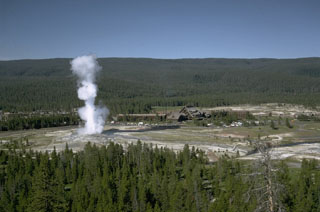Report on Yellowstone (United States) — September 1989
Scientific Event Alert Network Bulletin, vol. 14, no. 9 (September 1989)
Managing Editor: Lindsay McClelland.
Yellowstone (United States) Shallow steam explosion destroys geyser
Please cite this report as:
Global Volcanism Program, 1989. Report on Yellowstone (United States) (McClelland, L., ed.). Scientific Event Alert Network Bulletin, 14:9. Smithsonian Institution. https://doi.org/10.5479/si.GVP.SEAN198909-325010
Yellowstone
United States
44.43°N, 110.67°W; summit elev. 2805 m
All times are local (unless otherwise noted)
The following is from Roderick Hutchinson. "At approximately 1440 on 5 September, Porkchop Geyser in the Norris Geyser Basin (roughly 44.7°N, 110.7°W) of Yellowstone National Park was destroyed by a shallow steam explosion. Eight visitors witnessed its water-steam mixture eruption column reach an estimated height of 20-30 m from its normal 6-9 m shortly before the whole siliceous sinter formation suddenly blew up. In 'just a few seconds' it threw sinter blocks out in a fan-like manner, mainly to the N and S, rupturing the geyser's vent, hot water basin, and surrounding sinter sheet platform. Maximum range of ejecta was 66.1 m S, 43.4 m N, 31.5 m W, and only 25.6 m E toward the boardwalk. An ejecta rim 1-1.4 m high, 13.9 m long on a N-S axis, and 11.7 m wide was formed around a newly created boiling spring. Much of its volume consisted of large sheets or plates of moderate to dense siliceous sinter buckled loose from the floor of the thermal basin and thrust vertically or overturned. The largest sinter block cast out had dimensions of 1.88 x 1.23 x 0.75 m. Within the ejecta rim, a new hot spring, supersaturated with silica, has emerged and is currently 5.5 x 4.0 m across and 3.23 m deep.
"Porkchop Geyser was a small unnamed spring, notable at least as early as 1927, because of its exceptionally high contents of Cl and SiO2; it remained unnamed until 1961, when it was informally called Dr. More's Porkchop by Donald E. White of the USGS, and later shortened to Porkchop Geyser. The name was derived from the shape of the geyser's pool. Porkchop normally had a slightly surging non-opalescent discharge; rarely, a geyser eruption 3-5 m high emptied its pool. Beginning in late Mar 1985, it started erupting as a perpetual spouter from an empty crater through its 2'3.5 cm triangular vent. Over the last 4 years, the geyser's eruption column was of sufficient velocity to be atomized into a fine spray that during winter formed ice cones > 7 m high and produced an eruption roar audible up to 2 km away.
"The destruction of Porkchop Geyser coincided with and was probably triggered by an annual widespread thermal disturbance in the Norris Geyser Basin. These hydrothermal events are characterized by briefly increased water and gas discharge, increased turbidity, extreme fluctuations in surface temperatures, alteration of geyser eruptive patterns, and in some years also include the creation of new thermal features. These disturbances have been observed nearly every year since 1971 when more detailed record keeping began."
Further References. Dzurisin, D., and Yamashita, K., 1987, Vertical surface displacements at Yellowstone Caldera, Wyoming, 1976-1986: JGR, v. 92, p. 13,753-13,766.
Smith, R.B., Reilinger, R., Meertens, C., Hollis, J., Holdahl, S., Dzurisin, D., Gross, W., and Klingele, E., 1989, What's moving at Yellowstone?; the 1987 crustal deformation survey from GPS, leveling, precision gravity, and trilateration: EOS, v. 70, p. 113, 119, 123-125.
Geological Summary. The Yellowstone Plateau volcanic field developed through three volcanic cycles spanning two million years that included some of the world's largest known eruptions. Eruption of the over 2,450 km3 Huckleberry Ridge Tuff about 2.1 million years ago created the more than 75-km-long Island Park caldera. The second cycle concluded with the eruption of the Mesa Falls Tuff around 1.3 million years ago, forming the 16-km-wide Henrys Fork caldera at the western end of the first caldera. Activity subsequently shifted to the present Yellowstone Plateau and culminated 640,000 years ago with the eruption of the over 1,000 km3 Lava Creek Tuff and the formation of the present 45 x 85 km caldera. Resurgent doming subsequently occurred at both the NE and SW sides of the caldera and voluminous (1000 km3) intracaldera rhyolitic lava flows were erupted between 150,000 and 70,000 years ago. No magmatic eruptions have occurred since the late Pleistocene, but large hydrothermal events took place near Yellowstone Lake during the Holocene. Yellowstone is presently the site of one of the world's largest hydrothermal systems, including Earth's largest concentration of geysers.
Information Contacts: Roderick A. Hutchinson, Yellowstone National Park.

